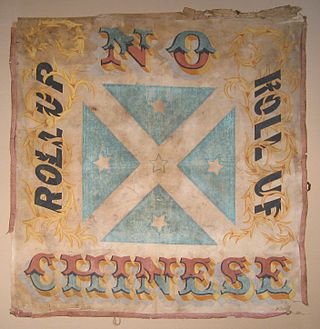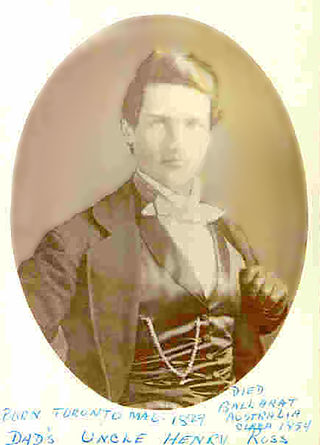
The Eureka Rebellion was a series of events involving gold miners who revolted against the British colonial government in Victoria, Australia during the Victorian gold rush. It culminated in the Battle of the Eureka Stockade, which took place on 3 December 1854 at Ballarat between the rebels and the colonial forces of Australia.

The Victorian gold rush was a period in the history of Victoria, Australia, approximately between 1851 and the late 1860s. It led to a period of extreme prosperity for the Australian colony and an influx of population growth and financial capital for Melbourne, which was dubbed "Marvellous Melbourne" as a result of the procurement of wealth.

The Eureka Flag was flown at the Battle of the Eureka Stockade, which took place on 3 December 1854 at Ballarat in Victoria, Australia. It was the culmination of the 1851–1854 Eureka Rebellion on the Victorian goldfields. Gold miners protested the cost of mining permits, the officious way the colonial authorities enforced the system, and other grievances. An estimated crowd of over 10,000 demonstrators swore allegiance to the flag as a symbol of defiance at Bakery Hill on 29 November 1854. It was then flown over the Eureka Stockade during the battle that resulted in at least 27 deaths. Around 120 miners were arrested, and many others were badly wounded, including five soldiers.

Peter Fintan Lalor was an Irish-Australian rebel and, later, politician who rose to fame for his leading role in the Eureka Rebellion, an event identified with the "birth of democracy" in Australia.

The Lambing Flat riots were a series of violent anti-Chinese demonstrations that took place in the Burrangong region, in New South Wales, Australia. They occurred on the goldfields at Spring Creek, Stoney Creek, Back Creek, Wombat, Blackguard Gully, Tipperary Gully, and Lambing Flat.

John Basson Humffray was a leading advocate in the movement of miner reform process in the British colony of Victoria, and later a member of parliament.

Henry Ross was a Canadian-Australian gold miner who died in the Eureka Rebellion at the Ballarat gold fields in the British Colony of Victoria, now the state of Victoria in Australia. Ross is particularly remembered for his part in the creation of the rebel miners' flag, since named the Eureka Flag.

Ballarat East is a suburb of Ballarat in Victoria, Australia. From 1857 until 1921 the suburb had its own council. The suburb covers a large area east of the city centre. It is the oldest urban area in Ballarat and was the site of many goldmines, as well as of the Eureka Rebellion.

The Ballarat Reform League came into being in October 1853 and was officially constituted on 11 November 1854 at a mass meeting of miners in Ballarat, Victoria to protest against the Victorian government's mining policy and administration of the goldfields.
The Miner's Right was introduced in 1855 in the colony of Victoria, replacing the Miner's Licence. Protests in 1853 at Bendigo with the formation of the Anti-Gold Licence Association and the rebellion of Eureka Stockade in December 1854 at Ballarat led to reform of the system with a lower annual fee of five shillings for the right to mine gold, the right to vote, and the right to own land. Previously, the mining licence cost eight pounds a year.

John King (1830-1881) was a police constable at the Battle of the Eureka Stockade who was responsible for seizing the rebel war flag.
The Ballarat Star was a newspaper in Ballarat, Victoria, Australia, first published on 22 September 1855. Its publication ended on 13 September 1924 when it was merged with its competitor, the Ballarat Courier.

William Bramwell Withers was a journalist and novelist best known for writing the first history of Ballarat, Victoria. Born in England, Withers moved to the Colony of Natal in 1849 and contributed to local newspapers. He moved to Victoria in 1852, working odd jobs before becoming a reporter for the Argus and the Herald in Melbourne.

The Battle of the Eureka Stockade was fought in Ballarat, Victoria, Australia on 3 December 1854, between gold miners and the colonial forces of Australia. It was the culmination of the 1851–1854 Eureka Rebellion during the Victorian gold rush. The fighting resulted in at least 27 deaths and many injuries, the majority of casualties being rebels. The miners had various grievances, chiefly the cost of mining permits and the officious way the system was enforced.

Since 2009, various theories have emerged, based on the Argus account of the Battle of the Eureka Stockade and an affidavit sworn by Private Hugh King three days later as to a flag being seized from a prisoner detained at the stockade, concerning whether a Union Jack, known as the Eureka Jack was also flown by the rebel garrison. Readers of the Argus were told that:
The flag of the diggers, "The Southern Cross," as well as the "Union Jack," which they had to hoist underneath, were captured by the foot police.
The following bibliography includes notable sources concerning the Eureka Rebellion. This article is currently being expanded and revised.

The Eureka Rebellion, an 1854 gold miner's revolt in Victoria, Australia, has been the inspiration for numerous novels, poems, films, songs, plays and artworks. Much of Eureka folklore relies heavily on Raffaello Carboni's 1855 book, The Eureka Stockade, which is the first and only comprehensive eyewitness account of the uprising. The poet Henry Lawson wrote about Eureka, as have many novelists.

The following is a comprehensive timeline of the Eureka Rebellion.

The Eureka Stockade Memorial Park is believed to encompass the site of the Battle of the Eureka Stockade that was fought in Ballarat, Victoria on 3 December 1854. Records of "Eureka Day" ceremonies at the site of the battle go back to 1855. In addition to the Eureka Stockade Monument, there are other points of interest in the reserve, including the Eureka Stockade Gardens and an interpretative centre. There was formerly a swimming pool and other structures. There has been a nearby caravan park since the 1950s. The present Eureka Stockade Memorial Park Committee has undergone several name changes since 1922.








